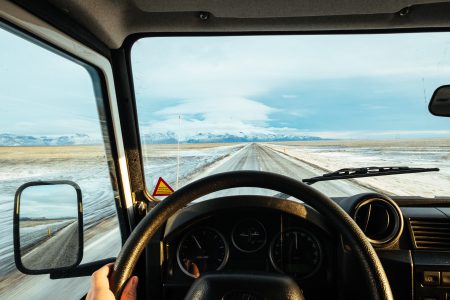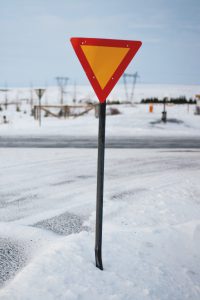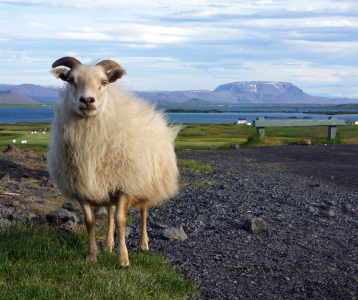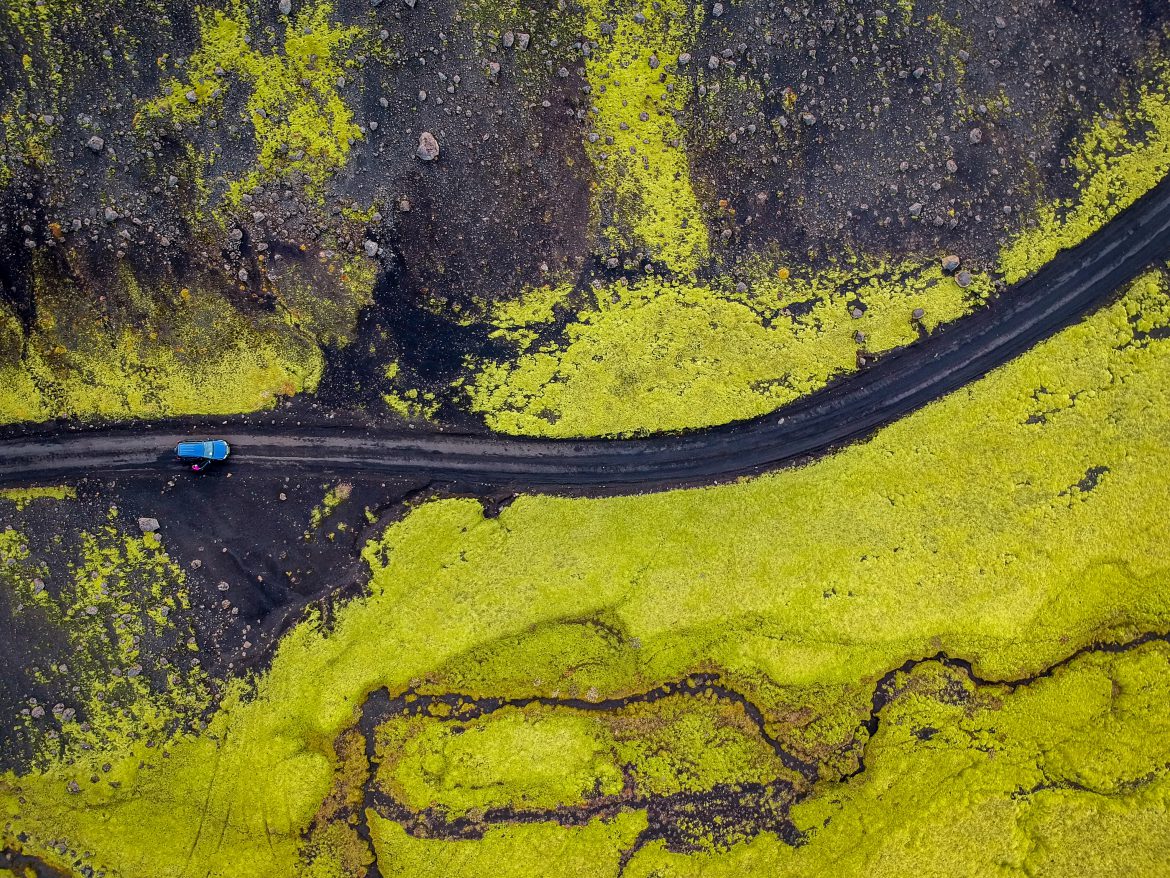Do you feel annoyed by the hustle and bustle and the noise in the city? Are you longing for peace and quiet and immersion in nature? Then pack your bags and explore Iceland, the island of “fire and ice”. A landscape of breathtaking beauty awaits you here. Rugged volcanoes, impressive glaciers and hot springs, so-called geysers, will give you a completely new attitude to life. To discover Iceland, you should travel by car or camper van, as there is no rail transport for passengers. Taxis and buses are also very expensive. As with any trip abroad with your own or rented vehicle, it is advisable to find out beforehand what rules apply when driving in Iceland.
 Road network in Iceland
Road network in Iceland
Slowly step on the accelerator, observe the speed limits and off you go to the great freedom of the Ring Road. This well-maintained route, 1,332 kilometres long, circles Iceland and resembles country roads in Germany. Given the fascinating natural scenery that surrounds you, you might be tempted to deviate from this route in order to penetrate the interior of the island. But driving in Iceland is not as easy as you might imagine. Trips beyond the ring road are sometimes forbidden or subject to conditions, and can also present some challenges and dangers.
The so-called F-roads leading inland is highland gravel roads that are only permitted for off-road vehicles. Except for 4×4 four-wheel-drive campers, campervans are not considered suitable for highland use. The F-roads are closed from November to May/June. Often, on these unpaved roads, you also get into the situation of having to drive through a stream. This so-called fording requires a lot of skill and foresight from the driver, because a trickle can quickly turn into a raging river when it rains, which could turn out to be a problem on the return journey. Or there may be a large stone on the bottom of the watercourse that can cause damage to the vehicle.
Iceland also has many single-lane bridges, 39 on the ring road alone. You should approach these at a reduced speed because caution is not the mother of fun, but the mother of china. In the event of oncoming traffic, the first person to reach the crossing has the right of way. However, you should not insist on this right, especially since driving in Iceland always involves mutual consideration. Maybe the other person doesn’t know the rules for crossing a bridge?
Right-hand traffic is the rule on the island. Driving in Iceland is brisk but relaxed and characterised by politeness. Pedestrians always have priority, even if they are not at a zebra crossing and still want to cross the road. Driving in Iceland means taking your time, not rushing from A to B and showing respect for others.
General driving regulations in Iceland
On the volcanic island in the North Atlantic, many regulations apply as they are known internationally. However, in contrast to some other countries where they are handled more laxly, non-compliance in Iceland results in draconian measures such as extremely high fines and even the suspension of driving licenses. Fines can be collected by the police directly on the spot.

- Speed
- Within built-up areas, 50 km/h or 30 km/h are permitted.
- 90 km/h may be driven on non-local asphalt roads by car or camper van.
- 80 km/h speed limit must be observed on extra-urban gravel roads.
- Alcohol
- In Iceland, the 0.5 per mille limit applies.
- Mobile phone
- It is only permitted to use the mobile phone in hand-free mode.
- Light
- It is obligatory to switch on the headlights around the clock.
- Seat belt
- Wearing a seat belt is a must as well as placing children in appropriate seats.
- Tyres
- From the beginning of November to mid-April, vehicles must be equipped with winter tyres.
Traffic signs
 As in Germany, for example, traffic signs in Iceland are divided into the following three categories: Prohibition, Mandatory or Danger signs. In addition, there are information boards with special instructions for tourists, but also for residents.
As in Germany, for example, traffic signs in Iceland are divided into the following three categories: Prohibition, Mandatory or Danger signs. In addition, there are information boards with special instructions for tourists, but also for residents.
Most signs are self-explanatory and similar to those in other countries of the world. The only differences are in the colour scheme. The predominantly round prohibition signs have a red border and yellow background. Mandatory signs have a blue background and a white border. Most danger signs have a triangular shape, a red border and a yellow background.
Many information signs and those that draw attention to a hazard are due to the special features of a volcanic island and can be found mainly outside of towns. These include, among others:
- Danger signs warning of an unclear hilltop. You should be especially alert here and expect possible oncoming traffic despite the low volume of traffic in Iceland.
- Danger signs warning of a river crossing. This requires a car with four-wheel drive and sufficient height. There are many car rental companies that expressly prohibit river crossings. Those who dare to do so and get stuck, for example, must expect to pay for the costs of recovery out of their own pockets.
- Information signs show a white “M” on a blue background. They indicate that there are alternative routes on narrow roads.
- Information signs on which a camera is depicted. These are not tips that the area is worth photographing. Rather, they are an announcement of speed controls. If you discover a so-called loop square, you are in the vicinity of a place of interest.
- Information signs depicting a bathing person and a thermometer. Here you have the opportunity to recover from your car journey in one of the many heated outdoor pools in Iceland.
Driving a camper van in Iceland
In Iceland, it has been forbidden to park your camper van in inhabited areas or outside campsites for several years. However, with over 60 campsites where there are usually plenty of free spaces, accommodating your vehicle should not be a problem. In addition, some farms also offer camping. Most campsites are open from around mid-May until the end of August.
As everywhere in Europe, the facilities have different facilities, which is reflected in the prices. On average, they range from twelve to 15 Euros per person per night. Extra costs such as electricity usually have to be paid separately.
Due to the rapidly changing and often extreme weather conditions in Iceland, it is advisable to adapt your itinerary with the camper van to them. If there is a strong wind forecast somewhere, it is better to choose an area where it does not blow so hard. For campers, it is also a good tip to take an off-road bicycle with you, as not all camper vans are allowed to travel inland. This way you have the opportunity to discover the beauties of the island and at the same time enjoy a holiday in your mobile home.
Insurance for the vehicle
In addition to comprehensive insurance, it makes sense to take out additional insurance for glass, underbody and tyres, as these parts of the vehicle can easily be damaged by stone chips. Some car rental companies will also offer you insurance against damage to the car caused by ash and sand. The best thing to do is to read the terms and conditions of your contract carefully to check what damage is already covered.
Tips
- If you stop to take photos in the endless expanse of the highlands, park your car against the wind so that the gusts of wind don’t blow the doors off when you get out. However, you may only park in the direction of travel.
- Check the tyre pressure regularly after a ride on gravel roads.
- Find out about current weather conditions, volcanic activity, water levels and avalanche risks. There are very good apps for this. Plan your route according to the most favourable conditions and don’t stick to it. If you want to travel by camper van, make sure that the wind is not stronger than 15 m/s.

- Concentrate while driving, because you must always be aware of animals such as horses or sheep crossing the road. If a herd of sheep gathers in front of your vehicle, you can carefully drive past them at the side of the road at walking speed. If you accidentally hit an animal, you should call emergency number 112, which will call the police. While you are waiting for the police to arrive, turn on your hazard lights and put up a warning triangle. This not only serves to warn other road users but also protects against the revenge of unpredictably reacting dams of injured foals or lambs, for example.
- Take binoculars with you, because you won’t get as close to all parts of the island as you’d like.
Conclusion: On the road in Iceland by campervan
The island of “fire and ice” is looking forward to your visit. Your time out of the daily grind will not be comparable to a relaxing holiday on a Mediterranean beach. Rather, a mixture of thrills and relaxation of a special kind awaits you in Iceland, because the unique nature shows both its threatening and its stunningly beautiful side. But if you stick to the prescribed rules of conduct, you are on the safe side, so that you will remember driving in Iceland as an unforgettable experience.
Globetrotters are looking for the extraordinary and like to move beyond mainstream tourism. Are you one of them? Iceland is still considered an insider tip. But the number of holidaymakers who are discovering this island as a destination for themselves is growing. So don’t hesitate for long, switch on the adventure turbo and get to know the rustic and tart land of the Vikings by car or camper van!
